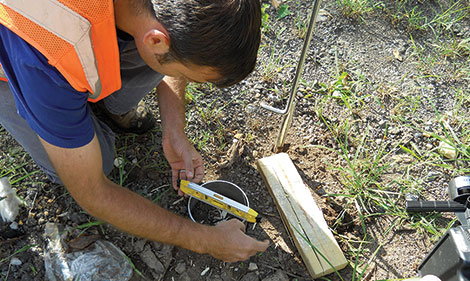Research Scientist reduces runoff protecting Chesapeake Bay
Schwartz reduces compaction of soil, increasing infiltration
GREEN AND CLEAN
Can Maryland’s green spaces help keep the Chesapeake Bay cleaner?
Source: UMBC Magazine
Stuart S. Schwartz, a senior research scientist at UMBC’s Center for Urban Environmental Research and Education (CUERE) is developing new methods that may help minimize potentially harmful runoff from green spaces into the Chesapeake Bay.
“What we find when you look around at construction sites is the way that we develop the landscape deeply disturbs [the soil],” says Schwartz.
One particular culprit is soil compaction, which allows runoff to flow more readily into the Chesapeake Bay or other bodies of water. So Schwartz and his team have devised a plan to loosen urban soils and mix them with vegetative compost to create a thicker, deeper soil that also allows more rainfall to infiltrate it and be retained in the soil, thus producing less runoff.
Schwartz’s plan adapts “subsoiling” – a technique commonly used in agriculture to break up the shallow compaction of soil that develops when farm vehicles go back and forth across fields. The researchers at CUERE are using deep ripping with heavy steel blades ripping (18 to 24 inches down) to pulverize the soil then they till organic material compost back into the ground.
The technique likely won’t have immediate applications in small residential yards where deep ripping would also tear up water, gas, and electrical utilities, though Schwartz says that in the right conditions (utilities on one side of houses, for instance), a collection of 25 to 50 homeowners on the same street who agreed to have it done might provide the proper economy of scale.
So in the meantime, Schwartz and his colleagues have secured a grant to test their method on vacant lots in Baltimore City where access is easier to obtain – and the researchers can also test other sustainable methods aimed at reducing pollutants even further.
Schwartz says that the tests on vacant lots are “also incorporating biochar, a very specialized form of black carbon, which has a high affinity for binding certain pollutants.”
Indeed, biochar might turn such sample lots (and any other space in which it is employed) into high-performance pollutant filters that will retain hydrocarbons, heavy metals and nutrients above and beyond what a normal soil can hold.
To accelerate the adoption of the deep ripping technique, the CUERE researchers hope to convince developers to use subsoiling at the time of building construction. Though challenges such as demolition debris that might pose constraints to deep ripping do remain, such collaborations would achieve the goal of reducing runoff and also minimize costs, since the technique requires just a little bit of extra time, an inexpensive commodity (compost) and a piece of equipment typically onsite already.
— Nicole Ruediger
Posted: February 11, 2013, 12:35 PM
